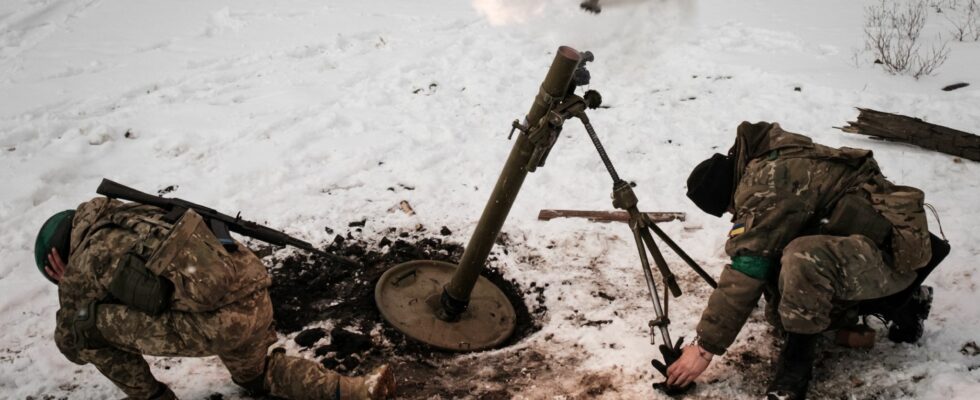This appalling video circulated on the Telegram network earlier this year. We see a Russian fighter – the camera is anchored on him and his face is not visible – leading an attack in the middle of the forest, throwing a grenade, then running to a large hole where two Ukrainian soldiers are entrenched. Surprised by this assault, they are quickly shot down by their adversary, who then continues his progress.
Beyond the horror they arouse, these images highlight the new approach taken by Vladimir Putin’s forces in recent weeks to gain ground. The offensive launched since January on the Donbass front is mainly carried out on foot, by small units, whose objective is to chase the enemy from his first line of defense. A very expensive tactic in lives. It allowed the Russians to progress slowly but surely around the industrial city of Bakhmout, where the situation was becoming “more and more complicated”, acknowledged Ukrainian President Volodymyr Zelensky on February 28.
“The Russian forces have evolved their mode of action compared to the beginning of the war, when they lacked a curtain of infantry to accompany their tanks, explained a French military source to L’Express, mid-February. As there are a lot of mines, problematic for armor, they have no other solution but to send in the infantry, which proceeds to infiltrate after the artillery has tested the Ukrainian defences.
This analysis was confirmed by a recently captured Russian military document, revealed on his Twitter account (@Tatarigami_UA) by a Ukrainian reserve officer. This tactical manual recommends that the assault detachment carry out its attack “less than a minute after artillery fire on enemy fortified positions”, never “in open space” and favoring “the edges of wood”. He advocates the division into tactical groups of three people, from platoons of 12 to 15 soldiers, to fight the enemy directly.
For the Ukrainian reserve officer, these tactical choices “seem to be influenced by Wagner’s advances in the Bakhmout region and the decrease in the availability of vehicles and weapons since February 2022”. In fact, for several weeks, testimonies from the front have reported frontal assaults in this sector by small units, which are gradually eating away at the ground on the Ukrainians.
However, this progression could be a double-edged sword for the Russians. In a recent tweet, Michael Kofman, director of Russia studies at the NAC, an American research institute, notes that the series of offensive operations launched by Russian Chief of Staff Valeri Gerasimov “may yield some gains”, but he considers these “unreflected” and “unlikely to change the strategic situation”. He argues that this “second battle for Donbass”, too expensive in men, “could again make the Russian forces vulnerable”. And therefore promote the success of a new Ukrainian counter-offensive, after those on Kherson and Kharkiv.
Admittedly, Bakhmout, in the process of being surrounded and whose supply is hanging by a thread, could fall soon. The Russians could also make progress on other points, thanks to the modus operandi highlighted by the manual. “But these tactical gains are likely to culminate quickly because of their small size, the US think tank Institute for the Study of War predicts in a note. Russian forces are unlikely to make any significant operational breakthroughs.” Because it is not enough to make micro-advances. It is still necessary to know how to exploit them, which “would require solid and mobile reserves, based on armored and mechanized forces, which have the leadership, the authority and the agility necessary to penetrate deep into Ukrainian territory, explains on his Twitter account Australian General Mick Ryan. It is highly likely that they would be detected and prevented by long-range Ukrainian fire.”
Faced with Ukrainian forces well buried or protected by solid fortifications, attacks carried out by armored vehicles prove to be very risky. The Russian effort in the area of the city of Vulhedar, south-west of that of Donetsk, ended in failure at the beginning of February. Under the eye of the drones, the Kremlin forces lost hundreds of men and dozens of armor on a flat and open ground, overwhelmed by a minefield and Ukrainian artillery pounding the Russian units.
“The great offensive of the Russians is going so well that no one realizes it,” Ukrainian intelligence chief Kyrylo Budanov joked in an interview with Forbes. They have a strategic objective: to reach the administrative borders of the Donetsk and Luhansk regions by March 31.” An ambition that seems difficult to achieve given the new tactics employed and the insufficient means that accompany them.
